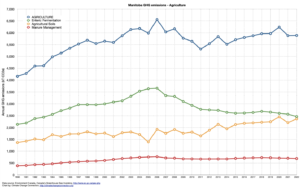Agriculture plays a unique role in the climate change challenge. While agriculture contributes a large portion of Manitoba’s greenhouse gas (GHG) emissions, it also has major potential for present and future carbon sequestration.
In 2022
Figure 1: In 2022, Agricultural practices produced 26% of Manitoba’s GHG emissions. NOTE: This does not include emissions from farm equipment or heating farm buildings. Those emissions are included on the Transportation and Stationary combustion pages. (1)
Manitoba’s agricultural emissions came from the following: (1)
- 43% – Soil management – mostly nitrous oxide from fossil-fuel based fertilizer (esp. if applied just before a rain)
- 45% – Enteric fermentation – gases animals expel as they digest their food (mostly burps)
- 12% – Manure management – mostly methane from anaerobic manure decomposition
Click here to download a printable PDF version of the charts and source data: Manitoba_GHG_trend_chart_1990-2022_agriculture.pdf (119 KB)
Manitoba agricultural emissions – 1990 to 2022
Figure 2: Manitoba’s agricultural greenhouse emissions have experienced the following increases from 1990 to 2022: (1)
- 41% higher – All agriculture
- 15% higher – Enteric fermentation
- 79% higher- Manure management
- 72% higher – Soil management
NOTE: All data are in CO2 equivalent kilotonnes per year. (1 kilotonne = 1000 tonnes = 1 million kilograms)






